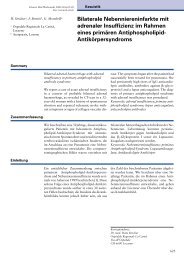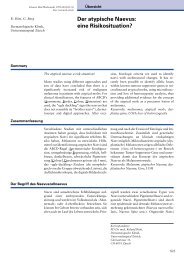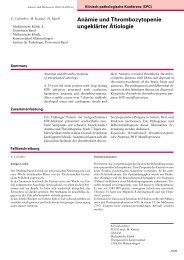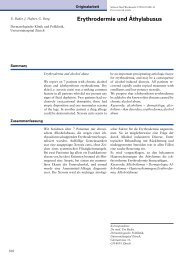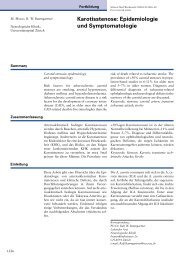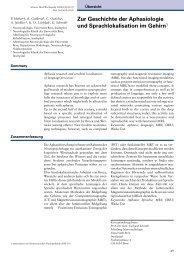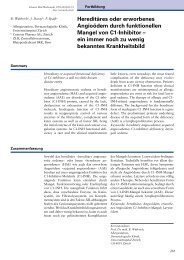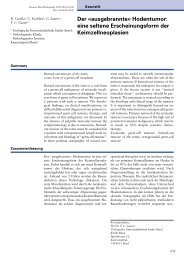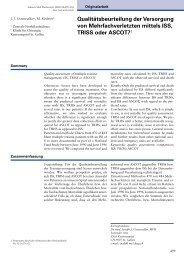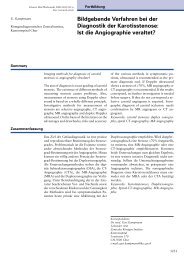SMW Supplementum 193 - Swiss Medical Weekly
SMW Supplementum 193 - Swiss Medical Weekly
SMW Supplementum 193 - Swiss Medical Weekly
Create successful ePaper yourself
Turn your PDF publications into a flip-book with our unique Google optimized e-Paper software.
7 S SWiSS Med Wkly 2012;142(Suppl <strong>193</strong>) · www.smw.ch Free communications<br />
FM21<br />
TcMEPS monitoring during spinal osteotomies<br />
for saggital imbalance<br />
Constantin Schizas1 , Etienne Pralong2 , Damien Debatisse3 ,<br />
Gerit Kulik1 1 2 CHUV Orthopaedics – spine surgery; CHUV Neurophysiology;<br />
3Uni-Klinik Köln – Neurophysiology<br />
Background: Kyphostic deformities with sagittal imbalance of the<br />
spine can be treated with spinal osteotomies. Those procedures are<br />
known to have a high incidence of neurological complications in<br />
particular at the thoracic level. Evoked motor potentials have been<br />
widely used in helping avoiding major neurological deficits post<br />
operatively. Previous reports have shown that a significant proportion<br />
of such cases present with important Tc MEP decreases during<br />
surgery with some of them being predictive of post operative deficits.<br />
The aim of our study was to look at the TcMEP changes in our series<br />
of patients and correlate them with clinical findings.<br />
Patients and methods: Seventeen patients were operated in a 2 year<br />
period, presenting with kyphosis of congenital, degenerative or post<br />
traumatic origin. Shortening subtraction osteotomies were performed<br />
in 9 patients at lumbar level (L1 to L4) and 8 at thoracic level<br />
(T1 to T12).<br />
Results: Intraoperatively all patients showed significant TcMEP<br />
changes. In particular a loss superior to 80% in at least one muscle<br />
group was observed in 4/8 patients in the thoracic group and 4/9<br />
patients in the lumbar group. No surgical maneuver was undertaken<br />
as a result of this loss in an effort to improve motor responses other<br />
than verifying the stability of the construct and the extent of the<br />
decompression. Only 3 patients developed post operative deficits,<br />
all of them being of radicular origin (two T1 level and one L3 level)<br />
recovering fully at 3 months post surgery. No relation was found<br />
between intraoperative blood pressure and TcMEP changes. In our<br />
series, severity of TcMEP did not correlate with post operative deficits.<br />
Discussion: TcMEP loss during major spinal surgery is of particular<br />
concern for physicians involved in this type of procedures. Although<br />
nearly all patients experienced loss of TcMEPs of some degree, only<br />
3 patients developed symptoms but those were relatively minor and<br />
transient. Even though every effort should be taken to improve motor<br />
responses by verifying the extend of the decompression and stability<br />
of the spine as well as maintaining blood pressure, it may be that such<br />
dramatic TcMEP changes need not to alert physicians since they do<br />
not appear to have a lasting clinical effect. Total loss of TcMEP (not<br />
witnessed in our series) might require more drastic approach with<br />
possible reversal of the correction and wake up test.<br />
FM22<br />
Gait analysis under real-life conditions in patients<br />
presenting with lumbar spinal stenosis<br />
Gerit Kulik1 , Romain Pittier1 , Anisoara Ionescu2 ,<br />
Nikos Tzinieris1 , Kamiar Aminian2 , Constantin Schizas1 1 2 CHUV; EPFL<br />
Introduction: The diagnosis of lumbar spinal stenosis (LSS) is based<br />
on patient history, clinical picture, and radiological findings. Although<br />
walking limitation is the cardinal sign of LSS, reports on its relation to<br />
symptom severity are contradictory. In addition, most studies looked at<br />
just a few walking cycles in a laboratory setting. Our primary aim was<br />
to quantify the gait parameters of LSS patients monitored under long<br />
time real life condition using ambulatory devices, in patients with LSS<br />
undergoing either conservative or surgical treatment. Our secondary<br />
aim was to identify differences between surgical and non surgical<br />
candidates on the basis of their gait parameters.<br />
Patients and Methods: Twenty eight patients (average age 71.4y,<br />
SD 10.4y), referred to a spinal surgeon with symptoms attributed to<br />
radiological stenosis of varying degrees and with neurogenic<br />
claudication were included. Symptom and radiological stenosis<br />
(morphological grade) severity was greater in 15 patients who<br />
subsequently underwent decompressive surgery (surgical group).<br />
Walking parameters were monitored during 8 hours daily over a period<br />
of five consecutive days, prior to any treatment (non-surgical, or<br />
surgical), using 2 miniature gyroscopes on thigh and shank. Periods<br />
>10s were analyzed with regards to walking speed, cadence, stride<br />
length and walking distance as well as gait variability. Walking distance<br />
was calculated and compared for the three longest periods recorded in<br />
each subject. Gait variability was expressed as coefficient of variability<br />
(CV) of the three longest recorded walking periods of each baseline<br />
measurement Statistical differences were analysed using t-test.<br />
Results: A total of 3757 walking episodes >10sec were analysed.<br />
Average values for cadence speed, and stride length were 99 ± 6.5<br />
steps/min, 3.1 ± 0.8 km/h, and 1 ± 0.2 m respectively in non-surgical<br />
group and 97 ± 10.6 steps/min, 2.9 ± 0.6 km/h, and 1 ± 0.2 m in<br />
surgical group. The average values of CV for speed, cadence and<br />
stride length were 0.12, 0.07 and 0.09 respectively in the non-surgical<br />
group and 0.14, 0.06 and 0.12 in the surgical group, representing a<br />
smaller gait variability in the non surgical. There was a trend towards<br />
longer walking distances, for the three longest monitored walking<br />
periods, in the non surgical group (239 ± 304m vs 110 m ± 111,<br />
p = 0.01)<br />
Conclusion: We found better walking capacities and less gait<br />
variability in the non surgical group. Although gait parameters might<br />
depend on a variety of factors, severity of symptoms and stenosis<br />
appear to have a measurable impact as observed in our two groups of<br />
patients. To our knowledge no previous study looked at physical<br />
activity over such a prolonged period in several subjects in the context<br />
of LSS. Future research into the reversibility of the aforementioned<br />
differences following treatment is underway.<br />
FM23<br />
Age-dependent normal values for bony, cartilaginous<br />
and labral coverage in the pediatric hip measured<br />
on MRI<br />
Hanspeter Huber 1 , Laurence Mainard-Simard 2 , Pierre Lascombes 2 ,<br />
Renaud Fay 2 , Jean-Baptiste Meyer 2 , Pierre Journeau 2<br />
1 Kinderspital Zürich; 2 CHU Nancy Hôpital d’Enfants<br />
Introduction: Residual dysplasia of the pediatric hip after treatment<br />
of developmental dysplasia of the hip is a common problem in clinical<br />
practice. Age-dependent normal values of the acetabular index as an<br />
important value of acetabular coverage are well known. Some hips<br />
that are clearly dysplastic according to these normal values do show<br />
a surprising maturation with normal coverage in the course. It was<br />
hypothesized that hips that present a normal cartilaginous coverage<br />
on MRI might develop favorable. However, normal values for<br />
cartilaginous and labral coverage on MRI are not known. The aim<br />
of our study was to establish age-related normal values of bony,<br />
cartilaginous and labral coverage of the pediatric hip on MRI.<br />
Methods: MR-images of hips were identified from the electronical<br />
archive. They had to meet the following inclusion criteria: no former<br />
treatment for developmental dysplasia of the hip, no hip pathology that<br />
might influence acetabular coverage or its measurement (no bone<br />
disorders such as epiphyseal dysplasia, Perthes disease, slipped<br />
capital femoral epiphysis or septic arthritis) and a contemporary Xray<br />
of the pelvis with an acetabular index below the 90. percentile of the<br />
age-related normal values according to Tönnis. MR images of 115 hips<br />
in 73 children were analysed and the bony, cartilaginous and labral<br />
acetabular index (AI bone/cartilage/labrum) was measured by two<br />
different observers in order to determine interobserver variability. The<br />
measurements were made on the coronal plane just posterior to where<br />
the triradiate cartilage between pubic and ischial bone was still visible.<br />
Percentile graphs were established from the Student’s t-distribution of<br />
the measurements grouped by 2 years of age.<br />
Results: Interobserver variability for the measurement of the AI bone<br />
was excellent (Intraclass correlation coefficient ICC 0.90). For the<br />
AI cartilage and labrum the ICC was somewhat lower (0.78) but<br />
interobserver variability was still rated as good. Percentile graphs<br />
of the AI bone, cartilage and labrum are presented. Although AI<br />
decreased during childhood, AI cartilage stayed relatively constant<br />
with the 50.percentile around 5 o and a 90. Percentile around 10 o .<br />
Conclusion: We present percentile graphs of age-related normal<br />
values. Although bony coverage increases during childhood<br />
cartilaginous coverage seems to stay constant. We think that this<br />
knowledge is a valuable adjunct in decision making when to indicate<br />
secondary surgery for residual dysplasia.<br />
FM24<br />
Periacetabular triple innominate osteotomy for<br />
improved containment of hips with poor prognosis after<br />
Legg-Calvé-Perthes-Waldenstroem (LCPW)<br />
G. Ulrich Exner1 , Adam Magyar2 , Pascal Schai3 1OrthopaedieZentrum (OZZ); 2ozz; 3KSL Wolhusen<br />
Introduction: Patients with LCPW who develop hip contracture and<br />
decentration of the femoral head usually have a poor prognosis. In<br />
1992 GUE has begun to use periacetabular triple osteotomies in<br />
selected patients with lateralization of the femoral head and secondary<br />
dysplastic development of the acetabulum to reconstitute containment<br />
of the femoral head within the acetabulum. Functional arthrograms<br />
were performed before surgery to exclude severe hinge abduction,<br />
which is considered a contraindication.<br />
Patients and Methods: 14 patients (16 hips) with CLPW and lateral<br />
extrusion of the femoral head and secondary dysplastic development<br />
of the acetabulum have been treated by triple innominate osteotomy<br />
(TIO) for lateralization and dysplastic acetabular development with a<br />
subinguinal adductor approach. Age at triple osteotomy ranged from<br />
4 to 11 years (avg. 6.8y). Besides standard radiographs the indication<br />
was based on dynamic standard radiographic or MRI arthrograms.<br />
The more recent cases were pre- and postoperatively studied by<br />
quantitative CT. The TIO was performed at 9 to 30 months<br />
(avg. 18 months) after the first symptoms.<br />
Results: All hips at follow-up (5 to 17 years, avg. 9 years after surgery)<br />
have developed concentrically and in most cases sphericity was




